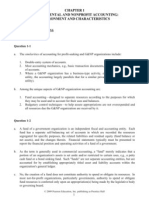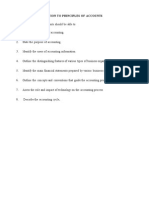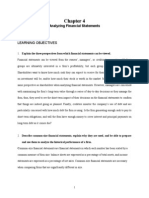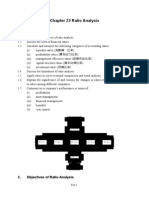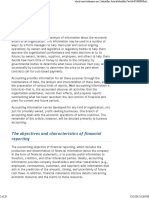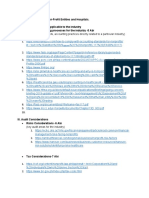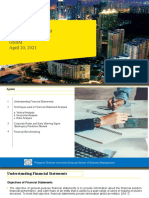0 ratings0% found this document useful (0 votes)
Governmental and Nonprofit Accounting: Environment and Characteristics
Governmental and Nonprofit Accounting: Environment and Characteristics
Uploaded by
MadchestervillainThis document discusses key differences between accounting for profit-seeking versus governmental and nonprofit (G&NP) organizations. It notes that while they share some similarities like the double-entry system, G&NP accounting is unique in its use of fund accounting to separate resources by intended use. It also discusses how G&NP organizations rely more on taxes, donations, and government grants rather than profits. Performance is also evaluated differently as G&NP organizations do not have a profit motive. Authoritative standards for G&NP accounting are set by the Governmental Accounting Standards Board, while the Financial Accounting Standards Board sets standards for other nonprofits.
Copyright:
© All Rights Reserved
Available Formats
Download as DOC, PDF, TXT or read online from Scribd
Download as doc, pdf, or txt
Governmental and Nonprofit Accounting: Environment and Characteristics
Governmental and Nonprofit Accounting: Environment and Characteristics
Uploaded by
Madchestervillain0 ratings0% found this document useful (0 votes)
This document discusses key differences between accounting for profit-seeking versus governmental and nonprofit (G&NP) organizations. It notes that while they share some similarities like the double-entry system, G&NP accounting is unique in its use of fund accounting to separate resources by intended use. It also discusses how G&NP organizations rely more on taxes, donations, and government grants rather than profits. Performance is also evaluated differently as G&NP organizations do not have a profit motive. Authoritative standards for G&NP accounting are set by the Governmental Accounting Standards Board, while the Financial Accounting Standards Board sets standards for other nonprofits.
Original Description:
Governmental and nonprofit accounting: environment and characteristics_CH 1 sol
Original Title
SM_CH01
Copyright
© © All Rights Reserved
Available Formats
DOC, PDF, TXT or read online from Scribd
Share this document
Did you find this document useful?
Is this content inappropriate?
This document discusses key differences between accounting for profit-seeking versus governmental and nonprofit (G&NP) organizations. It notes that while they share some similarities like the double-entry system, G&NP accounting is unique in its use of fund accounting to separate resources by intended use. It also discusses how G&NP organizations rely more on taxes, donations, and government grants rather than profits. Performance is also evaluated differently as G&NP organizations do not have a profit motive. Authoritative standards for G&NP accounting are set by the Governmental Accounting Standards Board, while the Financial Accounting Standards Board sets standards for other nonprofits.
Copyright:
© All Rights Reserved
Available Formats
Download as DOC, PDF, TXT or read online from Scribd
Download as doc, pdf, or txt
0 ratings0% found this document useful (0 votes)
Governmental and Nonprofit Accounting: Environment and Characteristics
Governmental and Nonprofit Accounting: Environment and Characteristics
Uploaded by
MadchestervillainThis document discusses key differences between accounting for profit-seeking versus governmental and nonprofit (G&NP) organizations. It notes that while they share some similarities like the double-entry system, G&NP accounting is unique in its use of fund accounting to separate resources by intended use. It also discusses how G&NP organizations rely more on taxes, donations, and government grants rather than profits. Performance is also evaluated differently as G&NP organizations do not have a profit motive. Authoritative standards for G&NP accounting are set by the Governmental Accounting Standards Board, while the Financial Accounting Standards Board sets standards for other nonprofits.
Copyright:
© All Rights Reserved
Available Formats
Download as DOC, PDF, TXT or read online from Scribd
Download as doc, pdf, or txt
You are on page 1/ 12
CHAPTER 1
GOVERNMENTAL AND NONPROFIT ACCOUNTING:
ENVIRONMENT AND CHARACTERISTICS
ANSWERS TO QUESTIONS
Question 1-1
a. The similarities of accounting for profit-seeking and G&NP organizations include:
1. Double-entry syste of accounts.
!. "ost accounting echanics# e.g.# basic transaction docuents# $ournals# ledgers# charts
of accounts.
%. &here a G&NP organization has a business-type acti'ity# e.g.# a unicipal electric utility#
the accounting largely parallels that for a siilar pri'ate business (e.g.# electric utility).
b. *ong the uni+ue aspects of G&NP organization accounting are:
1. ,und accounting-designed to separate resources according to the purposes for .hich
they ay be used and to account for their uses and balances.
!. /udgetary control techni+ues-to help assure appropriations are not o'ere0pended and
all resources due the G&NP organization are recei'ed by it.
Difficulty: 1
1earning 2b$ecti'e: 1
**34/: 5eflecti'e thinking
Question 1-
a. * fund of a go'ernent organization is an independent fiscal and accounting entity. 6ach
fund has a separate self-balancing set of accounts in .hich are recorded the resources
segregated for specific purposes# the related liabilities and residual e+uity (fund balance or net
assets)# and the changes therein. ,inancial stateents typically ust be presented to report
the financial position and operating acti'ities of a fund of a go'ernent.
b. *s the ter is generally used in coercial accounting# a 7fund7 erely indicates that a
portion of an organization8s assets is set aside and9or restricted to certain uses# e.g.# a petty
cash fund or a bond sinking fund. 4uch 7funds7 are not separate accounting entities# but are
accounted for by establishing appropriately titled asset and liability accounts .ithin the
organization8s general ledger.
c. No# the creation of a fund does not constitute authority to spend or obligate its resources. :n
ost not-for-profit organizations# particularly go'ernents# authority to spend or obligate
fund resources is conferred only upon an appropriation(s) being ade by the legislati'e body
or go'erning board.
1
Difficulty: !
1earning 2b$ecti'e: 1
**34/: 5eflecti'e thinking
Question 1-!
1. Governmental (e0pendable) funds are used to account for the financial assets; related
liabilities; changes in net financial assets fro re'enues# e0penditures# and other financing
sources (uses); and the balances that ay be e0pended in a G&NP organization8s
7go'ernental7 or other7 nonproprietary7 acti'ities.
!. Proprietary (none0pendable) funds are used to account for the re'enues# e0penses# assets#
liabilities# and e+uity of a G&NP organization8s 7business-type7 acti'ities# .hich in the ost
clear cut situations are intended to sustain their operations through user charges.
Difficulty: 1
1earning 2b$ecti'e: <
**34/: 5eflecti'e thinking
Question 1-"
7Expenditures7 ay be defined as the aount of net financial resources e0pended during an
accounting period for current operations# capital outlay# and long-ter debt principal retireent
and interest. (60penditures are easured in go'ernental fund accounting.) 7Expenses#7 on the
other hand# are the costs of assets or ser'ices consued (e0pired) during an accounting period.
(60penses are easured in proprietary fund accounting.) &hen e+uipent is purchased for
instance# e0penditures are incurred; but e0penses are incurred during its period of use.
Difficulty: 1
1earning 2b$ecti'e: !
**34/: 5eflecti'e thinking
Question 1-#
a. Organizational objectives. The deterination of net incoe# earnings per share# change in
o.ner(s) e+uity# and the like are 'ery iportant in accounting for profit-seeking
!
organizations. /ecause the basic purpose of a business is to generate re'enues sufficient to
co'er all costs of pro'iding the ser'ices and to generate a return for o.ners# these
easureents relate directly to the ob$ecti'es of the o.ners and are seen to indicate
anageent success or failure during a gi'en period of tie.
2n the other hand# a G&NP organization e0ists to pro'ide certain goods or ser'ices to a
counity or society as a .hole. The ob$ecti'e of such organizations is to pro'ide as any
goods or as uch ser'ice as a'ailable resources perit. ,or ost go'ernent and not-for-
profit entity ser'ices# there is no e0pectation that pro'iding the ser'ices .ill generate
re'enues or that any re'enues raised through user charges .ill co'er costs. 6phasis in this
en'ironent is therefore upon ac+uiring and using appropriable financial resources-cash
flo.# .orking capital# and budgetary position-rather than the deterination of net incoe
or earnings per share.
b. Sources of financial resources. Profit-seeking organizations generally rely on e+uity
in'estors# debt issuances# and profits fro the sale of goods and ser'ices to its custoers to
generate financial resources. :n contrast# G&NP organizations do not ha'e =in'estors#> and
generally do not ha'e a profit oti'e. G&NP organizations generally rely on the receipt of
ta0es and donations as their priary sources of financial resources although they also rely# to
soe degree# on proceeds fro debt issuances. Grants and subsidies fro go'ernents are
priary sources of financial resources for any G&NP organizations as .ell. /ureau of the
3ensus statistics indicate that resources recei'ed fro senior le'els of go'ernent actually
e0ceed ta0es for any local go'ernents.
c) Evaluating Performance and Operating Results$ Profit-seeking organizations rely on profits
fro the sale of its goods or ser'ices to continue to operate. The operations of a profit-
seeking organization generally are e'aluated based on the aounts of profits (or its net
incoe) o'er a period of tie. G&NP organizations ust be easured differently because
G&NP organizations generally do not ha'e a profit oti'e. 6'aluating the perforance of
go'ernents is e0treely difficult because there is no open arket supply and deand test of
the 'alue of the ser'ices that they pro'ide. *lso# the relationship bet.een resource pro'iders
and the recipients of ser'ices is reote and indirect for G&NP organizations. Therefore#
other controls ust be substituted for the profit test9regulator .here G&NP organizations are
in'ol'ed. Thus# G&NP organizations# particularly go'ernents# are sub$ected to a 'ariety of
legal and adinistrati'e controls o'er such factors as (1) organization structure# (!) personnel
policies and procedures# (%) sources of resources# (<) uses of resources# (?) accounting# (@)
reporting# and (A) auditing. The ost ob'ious result of such alternati'e controls is the
e0tensi'e use of fund accounting and reporting and budgetary accounting and reporting by
G&NP organizations
Difficulty: !
1earning 2b$ecti'e: %
**34/: 5eflecti'e thinking
Question 1-%
%
1. The Governmental Accounting Standards Board (GASB) .as established in 1BC< as the
recognized body to set authoritati'e standards for state and local go'ernent accounting and
financial reporting. The G*4/ recognized the effecti'e National 3ouncil on Go'ernental
*ccounting (N3G*) pronounceents and e0cerpts fro certain *:3P* publications as
7authoritati'e7 in 1BC<# and subse+uently has issued nuerous 4tateents and
:nterpretations.
!. The Financial Accounting Standards Board (FASB) assued responsibility for all
nonbusiness organization accounting and financial reporting standards e0cept those for state
and local go'ernents in 1BAB. The ,*4/ establishes accounting and financial reporting
standards for all nonprofit organizations e0cept for go'ernent nonprofit organizations.
(*lthough not discussed in chapter 1# it ay be interesting to note that the ,*4/ issued
4tateent of ,inancial *ccounting 4tandards (4,*4) No. 11@# 7*ccounting for
3ontributions "ade and 3ontributions 5ecei'ed7 and 4,*4 11A# 7,inancial 4tateents of
Not-for-Profit 2rganizations7 in Dune 1BB%. The ,*4/ has since issued t.o additional
standards specifically addressing not-for-profit organization accounting issues. These
standards established the general guidelines for financial reporting for all nongo'ernent not-
for-profit organizations-including nongo'ernent not-for-profit hospitals# colleges and
uni'ersities# 'oluntary health and .elfare organizations# and other not-for-profit
organizations. Go'ernent not-for-profit entities of these types# e.g.# state uni'ersities# are
prohibited fro applying the guidance in these standards# .hich are not included in the
,*4/Es *ccounting 4tandards 3odification.)
Difficulty: 1
1earning 2b$ecti'e: @
**34/: 5eflecti'e thinking
<
Question 1-&
Fser charges of profit-seeking organiations ay be presued to be set at a le'el that is e0pected
to a0iize short-run or long-run profitability. * potential user .ho cannot pay the user charges
is denied the goods or ser'ices.
:n G!"P organiations# on the other hand# user charges ay be set at odest le'els that assure
that ost or all people needing the goods or ser'ices can obtain the. The user charges ay be
ade ore as a atter of assuring that the users truly need the goods or ser'ices and9or to assure
that the self-respect of those .ho .ill not accept 7charity7 is protected. :n other G&NP acti'ities
user charges ay be set at a 7break e'en7 le'el or at le'els that pro'ide soe 7profit7 to be used
to e0pand or ipro'e its ser'ices.
Difficulty: 1
1earning 2b$ecti'e: %
**34/: 5eflecti'e thinking
Question 1-'
The ter 7generally accepted accounting principles7 has been defined broadly as:
1. encopassing the con'entions# rules# and procedures necessary to define accepted
accounting practice at a particular tie# and
!. including not only broad guidelines of general application# but also detailed practices and
procedures. (*P/ 4tateent No. <# par. 1%C). Thus# G**P is an 7ubrella7 ter that
encopasses any 7subsets7 in the pri'ate sector (e.g.# otion pictures# oil and gas#
banking) as .ell as in the public sector (e.g.# state and local go'ernents# hospitals#
colleges and uni'ersities# and not-for-profit organizations).
Difficulty: 1
1earning 2b$ecti'e: @
**34/: 5eflecti'e thinking
Question 1-(
a. The G*4/ (i.e.# go'ernent) GAAP #$ierarc$y> guidelines pro'ide accountants and
auditors a ranking de'ice by .hich to e'aluate the relati'e authoritati'eness of 'arious
standards pronounceents and other accounting and reporting publications in order to
deterine .hat constitutes 7generally accepted accounting principles7 for a gi'en type of
organization and the transactions and e'ents affecting its financial condition and9or operating
results.
b. The government GAAP $ierarc$y establishes G*4/ 4tateents and :nterpretations as the
ost authoritati'e literature guiding financial reporting for state and local go'ernent
?
entities. Therefore# in preparing G**P financial stateents# a go'ernent should apply the
guidance in a G*4/ 4tateent e'en .hen it conflicts .ith guidance pro'ided in an *:3P*
audit and accounting guide (or in any other literature).
Difficulty: 1
1earning 2b$ecti'e: @
**34/: 5eflecti'e thinking
Question 1-1)
The G*4/ and ,*4/ $ointly established a definition of =state and local go'ernent entities> that
appears in 'arious *:3P* audit and accounting guides (:llustration 1-1# page C). &hether a
specific not-for-profit organization should follo. G*4/ guidance or ,*4/ guidance depends on
.hether the organization +ualifies as a go'ernent organization under this definition.
%f the organization meets the definition of =state and local go'ernent entities#> it is under the
G*4/Es $urisdiction and should follo. GASB guidance.
%f the organization does not eet the =state and local go'ernent entities> definition# it is under
the ,*4/Es $urisdiction and should follo. FASB guidance.
Difficulty: 1
1earning 2b$ecti'e: A
**34/: 5eflecti'e thinking
@
SOLUTIONS TO E*ERCISES
E+e,-ise 1-1
1. d
!. d
%. c
<. b
?. a
@. d
A. e
C. c
B. c
1G. c
Difficulty: 1
1earning 2b$ecti'e: 1# !# %# <# @
**34/: 5eflecti'e thinking
E+e,-ise 1-
(a)
60penses
(b)
60penditures
1. 4alaries and other personnel costs ........................................... H1GG#GGG H1GG#GGG
!. 5ent and utilities....................................................................... !<#GGG !<#GGG
%. Debt ser'ice:
a) :nterest on note ........................................................... ?#?GG ?#?GG
b) Note principal payent ..................................................... - 1G#GGG
<. 3apital outlay9Depreciation:
a) 3apital outlay .................................................................... - %G#GGG
b) Depreciation of e+uipent
i) H1?G#GGG91? I H1G#GGG
ii) (H%G#GGG-H@#GGG)9@ I <#GGG 1<#GGG -
?. 2ther ........................................................................................ <#?GG <#?GG
Total ............................................................................... H1<C#GGG H1A<#GGG
Difficulty: !
1earning 2b$ecti'e: %# <
**34/: *nalytical 4kills
A
SOLUTIONS TO PRO.LEMS
P,o/0e1 1-1
1.
General ,und
Jatcher To.nship
&orksheet to Deri'e *ccrual /asis 4tateent of 5e'enues and 60penditures
,K6 Deceber %1# !GLB
(H)
/udgetary
(3ash) *ccruals G**P
/asis 1919LB 1!9%19LB /asis
5e'enues:
Ta0es .............................. H?B?#GGG H - H @#GGG H@G1#GGG
1icenses .......................... !G@#GGG - - !G@#GGG
:ntergo'ernental .......... 11G#GGG (B#GGG) 1#GGG 1G!#GGG
2ther .............................. <?#GGG (?#GGG) - <G#GGG
B?@#GGG H(1<#GGG) H A#GGG B <B#GGG
60penditures:
4alaries ........................... AG<#GGG H(1A#GGG) H11#GGG @BC#GGG
Ftilities ........................... C?#GGG - - C?#GGG
4upplies .......................... @<#GGG - A#GGG A1#GGG
6+uipent ...................... ?C#GGG (!#GGG) 1!#GGG @C#GGG
2ther .............................. %1#GGG - - %1#GGG
B<!#GGG H(1B#GGG) H%G#GGG HB?%#GGG
60cess of 5e'enues
2'er (under) 60penditures . H 1<#GGG H (<#GGG)
5econciliation (Not 5e+uired):
60cess of 5e'enues 2'er (Fnder) 60penditures-/udgetary (3ash) /asis .
H1<#GGG
Decrease in 5e'enue accruals at 1!9%19LB ...................................................
(A#GGG)
:ncrease in 60penditure accruals at 1!9%19LB ...............................................
(11#GGG)
C
60cess of 5e'enues 2'er (Fnder) 60penditures-G**P /asis .................. H
(<#GGG)
B
P,o/0e1 1-1 2-ontinue34
!. Kes# readers .ould get differing ipressions of the !GLB 7operating results7 of the Jatcher
To.nship General ,und fro stateents of re'enues and e0penditures prepared on the
budgetary (cash) and G**P bases. ,or e0aple:
a. 5e'enues e0ceeded e0penditures by H1<#GGG on the budgetary (cash) basis; but
e0penditures e0ceeded re'enues by H<#GGG on the G**P basis.
b. 5e'enue and e0penditure analyses and e'aluations .ould differ:
/udget
*ctual
(/udgetary
/asis)
*ctual
(G**P
/asis)
5e'enues:
Ta0es ...................................................... H@GG#GGG H?B?#GGG H@G1#GGG
:ntergo'ernental .................................. 1GG#GGG 11G#GGG 1G!#GGG
2ther ...................................................... ?G#GGG <?#GGG <G#GGG
60penditures:
4alaries ................................................... AGG#GGG AG<#GGG @BC#GGG
4upplies .................................................. AG#GGG @<#GGG A1#GGG
6+uipent .............................................. @G#GGG ?C#GGG @C#GGG
Difficulty: !
1earning 2b$ecti'e: ?
**34/: *nalytical 4kills
P,o/0e1 1-
The possible sources of guidance found for each issue are listed belo. in decreasing order of
authoritati'eness. Docuents at the sae le'el of authority are gi'en the sae rank since one
does not al.ays take precedence o'er the other. (1e'els *-D are fro the G**P =Jierarchy> in
:llustration 1-<# page 1!# of the te0tbook.)
Issue 1
1. (a)-G*4/ :nterpretation
!. (b)-G*4/ Technical /ulletin
!. (b)-*:3P* 41G *udit and *ccounting Guide (7cleared7 by the G*4/)
?. Nonauthoritati'e-,*4/ 4tateent (no. a section or portion of a section in the FASB
Accounting Standards Codifcation)
?. Nonauthoritati'e-1eading go'ernental accounting te0tbook
1G
P,o/0e1 1- 2-ontinue34
Issue 2
1. (d)-G*4/ staff :pleentation Guide
!. Nonauthoritati'e--1eading go'ernental accounting te0tbook
!. Nonauthoritati'e- *rticle in a leading auditing $ournal
!. Nonauthoritati'e- 4peech by a leading go'ernental accounting professor
Issue 3
1. (a)-G*4/ 4tateent
!. (b)-*:3P* 41G *udit and *ccounting Guide (=cleared> by the G*4/)
%. Nonauthoritati'e- Dournal article suarizing current practice on
%. Nonauthoritati'e- Notes fro a con'ersation .ith the G*4/ director of research
%. Nonauthoritati'e- ,*4/ :nterpretation
Issue 4
1. (b)-G*4/ staff Technical /ulletin
1. (b)-*:3P* 4tateent of Position (=cleared> by the G*4/)
%. Nonauthoritati'e-*rticle by international public accounting fir anaging partner
%. Nonauthoritati'e-,*4/ Technical /ulletin
Issue
1. (b)-*:3P* 41G *udit and *ccounting Guide (=cleared> by the G*4/)
!. (d)-G*4/ 3odification section on a G*4/ staff :pleentation Guide (has the
sae le'el of authority as the :pleentation Guide)M
%. Nonauthoritati'e-,our articles fro The Dournal of *ccountancy
%. Nonauthoritati'e-1eading go'ernental accounting te0tbook
M:pleentation guidance is not included in the 3odification. The purpose of the +uestion
.as to point out that the guidance in the 3odification includes aterial .ith 'arious le'els of
authority. The paragraph nubering syste indicates .ith the authoritati'e status of the
specific guidance. Nonauthoritati'e guidance has paragraph nubers ranging fro .BGG to .
BBB. Please forgi'e the unintended error in the +uestion.
Difficulty: !
1earning 2b$ecti'e: @# A
**34/: 5eflecti'e thinking
P,o/0e1 1-!
&ork on P1-% should be e'aluated by re'ie.ing the brief (1-% pages) criti+ues re+uired and any
attachents. The addresses of these sites are:
1. G*4/ (http:99....G*4/.org)
!. ,*4/ (http:99....,*4/.org)
%. *:3P*(http:99....*:3P*.org)
<. G,2* (http:99....G,2*.org)
?. *G* (http:99....*G*3G,".org)
11
@. N*4*3T (http:99....N*4*3T.org)
A. N*3F/2 (http:99....N*3F/2.org)
C. *4/2:NT1 (http:99*4/2:NT1.org)
P,o/0e1 1-"
The G*4/ &hite Paper can be found at the G*4/ .ebsite (....gasb.org). The e0ecuti'e
suary to the &hite Paper is a brief suary that identifies the key differences bet.een
go'ernents and for-profit business enterprises.
Difficulty: 1
1earning 2b$ecti'e: @# A
**34/: 5eflecti'e thinking
1!
You might also like
- F3 Mock Exam Practice Test (3 Pairs 110 QS) Q - S67% (6)F3 Mock Exam Practice Test (3 Pairs 110 QS) Q - S49 pages
- Solution Manual for Governmental and Nonprofit Accounting Theory and Practice 9th Edition by Freeman all chapter instant download100% (11)Solution Manual for Governmental and Nonprofit Accounting Theory and Practice 9th Edition by Freeman all chapter instant download47 pages
- Get Solution Manual for Governmental and Nonprofit Accounting Theory and Practice 9th Edition by Freeman free all chapters100% (6)Get Solution Manual for Governmental and Nonprofit Accounting Theory and Practice 9th Edition by Freeman free all chapters45 pages
- All chapter download Solution Manual for Governmental and Nonprofit Accounting Theory and Practice 9th Edition by Freeman100% (7)All chapter download Solution Manual for Governmental and Nonprofit Accounting Theory and Practice 9th Edition by Freeman46 pages
- Section 1: Introduction To Principles of AccountsNo ratings yetSection 1: Introduction To Principles of Accounts6 pages
- Chapter 1 Financial Management and Financial ObjectivesNo ratings yetChapter 1 Financial Management and Financial Objectives11 pages
- GAAP General Accepted Accounting PrinciplesNo ratings yetGAAP General Accepted Accounting Principles10 pages
- Chapter 23 Ratio Analysis: 1. ObjectivesNo ratings yetChapter 23 Ratio Analysis: 1. Objectives26 pages
- Chapter 5 - The Income State and The Statement of Cash FlowNo ratings yetChapter 5 - The Income State and The Statement of Cash Flow101 pages
- Smieliauskas 6e - Solutions Manual - Chapter 01No ratings yetSmieliauskas 6e - Solutions Manual - Chapter 018 pages
- Accounting As A Form of Communication: QuestionsNo ratings yetAccounting As A Form of Communication: Questions7 pages
- (Intermediate Financial (Intermediate Financial Accounting 1A) Accounting 1A)No ratings yet(Intermediate Financial (Intermediate Financial Accounting 1A) Accounting 1A)16 pages
- THE Development THE: OF Accounting Profession100% (1)THE Development THE: OF Accounting Profession21 pages
- Solution Audit and Internal Review Nov Ember2010No ratings yetSolution Audit and Internal Review Nov Ember20109 pages
- Subject: Corporate Financial Accounting: Nes Ratnam College of Arts, Science and CommerceNo ratings yetSubject: Corporate Financial Accounting: Nes Ratnam College of Arts, Science and Commerce64 pages
- 1 Financial Statements Cash Flows and TaxesNo ratings yet1 Financial Statements Cash Flows and Taxes13 pages
- Kunci Jawaban Analisis Laporan Keuangan Bab 7No ratings yetKunci Jawaban Analisis Laporan Keuangan Bab 750 pages
- Concepts in The Measurement of Income, The Price Level Problem, and Basic Concepts of Management ControlNo ratings yetConcepts in The Measurement of Income, The Price Level Problem, and Basic Concepts of Management Control14 pages
- Funds Analysis, Cash-Flow Analysis, and Financial Planning100% (1)Funds Analysis, Cash-Flow Analysis, and Financial Planning31 pages
- Auditing and Assurance Solutions To Questions50% (8)Auditing and Assurance Solutions To Questions79 pages
- Activity/Assignment #2 - Financial Models - Comparative DataNo ratings yetActivity/Assignment #2 - Financial Models - Comparative Data5 pages
- Comprehensive Problem - (Merchandising Concern)No ratings yetComprehensive Problem - (Merchandising Concern)19 pages
- Topic 7 - Bad Debts and Provision For Doubtful DebtsNo ratings yetTopic 7 - Bad Debts and Provision For Doubtful Debts35 pages
- Reading Financial Statements: Balance Sheet of Burns Ltd. (In TEUR) 31 Dec 20X5 31 Dec 20X4 Non-Current AssetsNo ratings yetReading Financial Statements: Balance Sheet of Burns Ltd. (In TEUR) 31 Dec 20X5 31 Dec 20X4 Non-Current Assets5 pages
- Financial Accounting I Final Practice Exam 1 - SolutionNo ratings yetFinancial Accounting I Final Practice Exam 1 - Solution5 pages
- IFRS 3 - Deferred and Contingent Consideration DiscussionNo ratings yetIFRS 3 - Deferred and Contingent Consideration Discussion20 pages
- Steps in The Accounting Process (Cycle) : Lecture NotesNo ratings yetSteps in The Accounting Process (Cycle) : Lecture Notes12 pages
- Consolidated Financial Statement BRNA Mar 2019No ratings yetConsolidated Financial Statement BRNA Mar 2019140 pages
- Chapter 6 Property Plant and Equipment Models77% (13)Chapter 6 Property Plant and Equipment Models41 pages
- Accounting Principles 10th Edition Weygandt Kimmel Chapter 3 PDF100% (1)Accounting Principles 10th Edition Weygandt Kimmel Chapter 3 PDF139 pages
- Study - Guide Income Statement To Cash FlowNo ratings yetStudy - Guide Income Statement To Cash Flow17 pages
- Solution Manual for Governmental and Nonprofit Accounting Theory and Practice 9th Edition by Freeman all chapter instant downloadSolution Manual for Governmental and Nonprofit Accounting Theory and Practice 9th Edition by Freeman all chapter instant download
- Get Solution Manual for Governmental and Nonprofit Accounting Theory and Practice 9th Edition by Freeman free all chaptersGet Solution Manual for Governmental and Nonprofit Accounting Theory and Practice 9th Edition by Freeman free all chapters
- All chapter download Solution Manual for Governmental and Nonprofit Accounting Theory and Practice 9th Edition by FreemanAll chapter download Solution Manual for Governmental and Nonprofit Accounting Theory and Practice 9th Edition by Freeman
- Chapter 1 Financial Management and Financial ObjectivesChapter 1 Financial Management and Financial Objectives
- Chapter 5 - The Income State and The Statement of Cash FlowChapter 5 - The Income State and The Statement of Cash Flow
- (Intermediate Financial (Intermediate Financial Accounting 1A) Accounting 1A)(Intermediate Financial (Intermediate Financial Accounting 1A) Accounting 1A)
- Subject: Corporate Financial Accounting: Nes Ratnam College of Arts, Science and CommerceSubject: Corporate Financial Accounting: Nes Ratnam College of Arts, Science and Commerce
- Concepts in The Measurement of Income, The Price Level Problem, and Basic Concepts of Management ControlConcepts in The Measurement of Income, The Price Level Problem, and Basic Concepts of Management Control
- Funds Analysis, Cash-Flow Analysis, and Financial PlanningFunds Analysis, Cash-Flow Analysis, and Financial Planning
- Case Studies in Not-for-Profit Accounting and AuditingFrom EverandCase Studies in Not-for-Profit Accounting and Auditing
- Summary of Richard A. Lambert's Financial Literacy for ManagersFrom EverandSummary of Richard A. Lambert's Financial Literacy for Managers
- Summary of Wayne Label's Accounting for Non-AccountantsFrom EverandSummary of Wayne Label's Accounting for Non-Accountants
- Activity/Assignment #2 - Financial Models - Comparative DataActivity/Assignment #2 - Financial Models - Comparative Data
- Topic 7 - Bad Debts and Provision For Doubtful DebtsTopic 7 - Bad Debts and Provision For Doubtful Debts
- Reading Financial Statements: Balance Sheet of Burns Ltd. (In TEUR) 31 Dec 20X5 31 Dec 20X4 Non-Current AssetsReading Financial Statements: Balance Sheet of Burns Ltd. (In TEUR) 31 Dec 20X5 31 Dec 20X4 Non-Current Assets
- Financial Accounting I Final Practice Exam 1 - SolutionFinancial Accounting I Final Practice Exam 1 - Solution
- IFRS 3 - Deferred and Contingent Consideration DiscussionIFRS 3 - Deferred and Contingent Consideration Discussion
- Steps in The Accounting Process (Cycle) : Lecture NotesSteps in The Accounting Process (Cycle) : Lecture Notes
- Accounting Principles 10th Edition Weygandt Kimmel Chapter 3 PDFAccounting Principles 10th Edition Weygandt Kimmel Chapter 3 PDF












